Menu Development and Planning: Analysis of Customer Needs
VerifiedAdded on 2023/06/13
|14
|4459
|419
Report
AI Summary
This report examines the principles of menu planning and design, focusing on meeting customer and business requirements within the hospitality industry, specifically referencing “The Woodspeen,” a Michelin-starred restaurant in the UK. It discusses key principles such as balance, variety, contrast, color, and eye appeal, along with different menu types like static, cyclic, and à la carte. The report identifies constraints in menu planning, including staff skills, guest preferences, production capabilities, and ingredient availability. It emphasizes the importance of understanding customer trends, tastes, and business needs to maximize profitability. The report compares and contrasts different menus, analyzes the impact of customer and business requirements on menu design, and recommends future trends. It also covers the development of a realistic menu plan, menu testing and evaluation, and recommendations for improvement to meet overall business objectives.
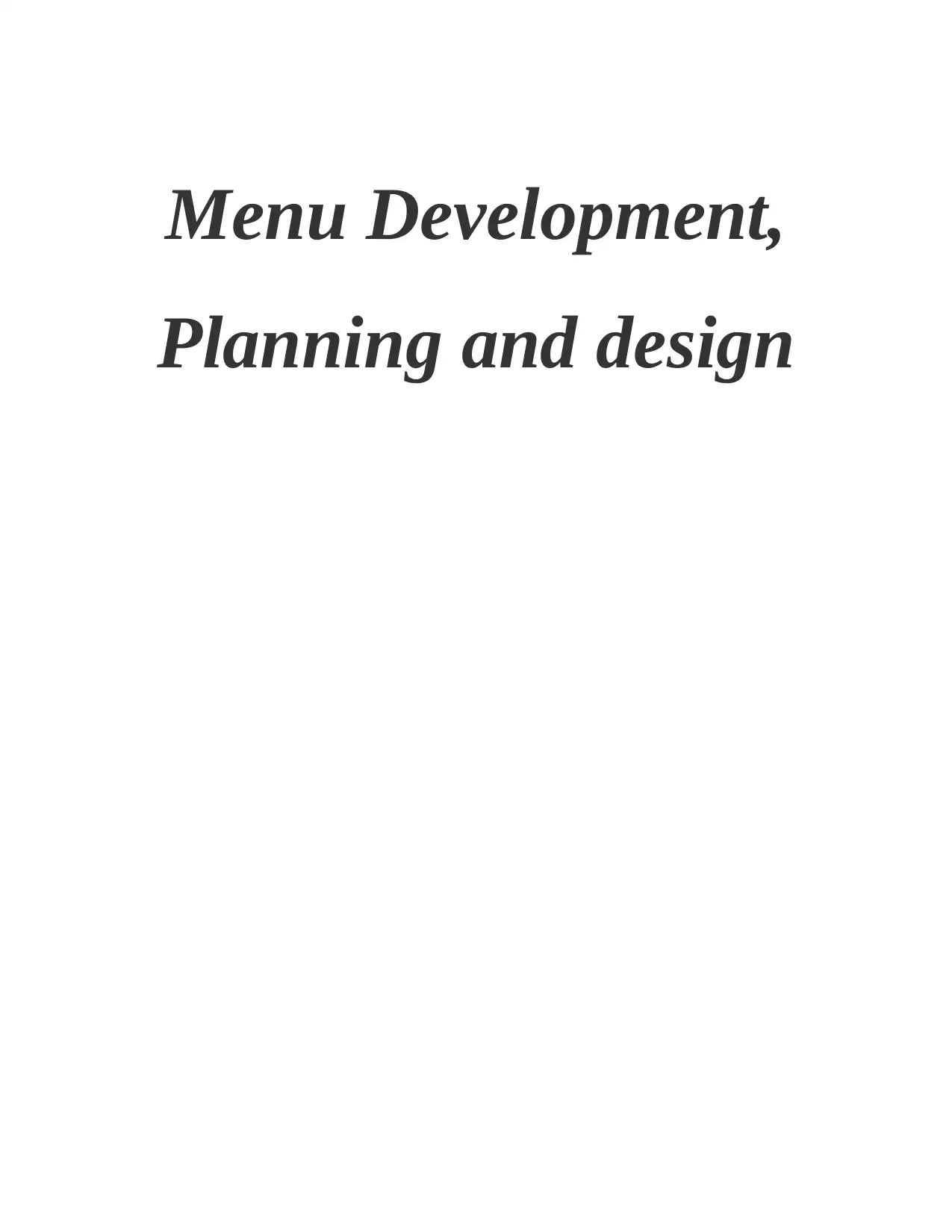
Menu Development,
Planning and design
Planning and design
Paraphrase This Document
Need a fresh take? Get an instant paraphrase of this document with our AI Paraphraser
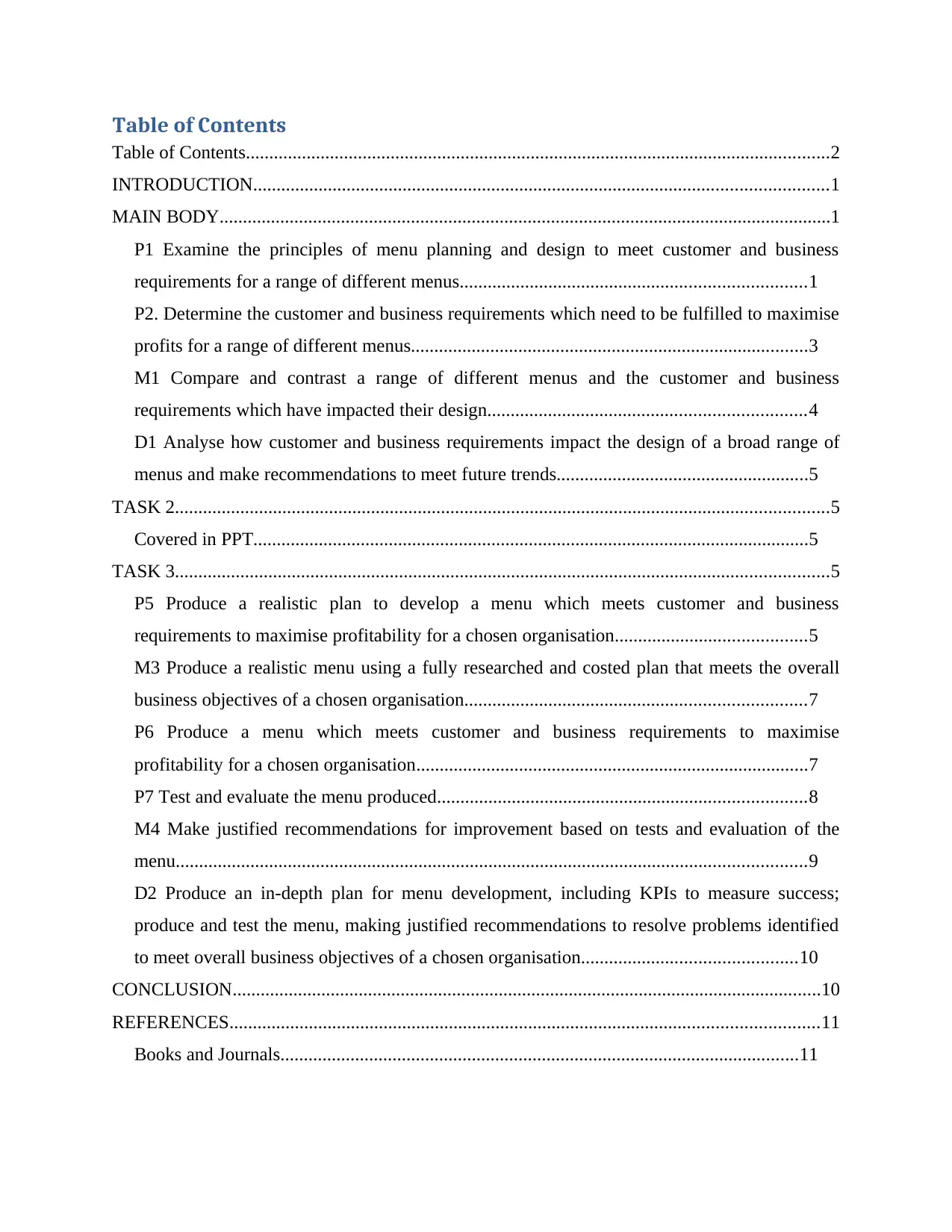
Table of Contents
Table of Contents.............................................................................................................................2
INTRODUCTION...........................................................................................................................1
MAIN BODY...................................................................................................................................1
P1 Examine the principles of menu planning and design to meet customer and business
requirements for a range of different menus..........................................................................1
P2. Determine the customer and business requirements which need to be fulfilled to maximise
profits for a range of different menus.....................................................................................3
M1 Compare and contrast a range of different menus and the customer and business
requirements which have impacted their design....................................................................4
D1 Analyse how customer and business requirements impact the design of a broad range of
menus and make recommendations to meet future trends......................................................5
TASK 2............................................................................................................................................5
Covered in PPT.......................................................................................................................5
TASK 3............................................................................................................................................5
P5 Produce a realistic plan to develop a menu which meets customer and business
requirements to maximise profitability for a chosen organisation.........................................5
M3 Produce a realistic menu using a fully researched and costed plan that meets the overall
business objectives of a chosen organisation.........................................................................7
P6 Produce a menu which meets customer and business requirements to maximise
profitability for a chosen organisation....................................................................................7
P7 Test and evaluate the menu produced...............................................................................8
M4 Make justified recommendations for improvement based on tests and evaluation of the
menu.......................................................................................................................................9
D2 Produce an in-depth plan for menu development, including KPIs to measure success;
produce and test the menu, making justified recommendations to resolve problems identified
to meet overall business objectives of a chosen organisation..............................................10
CONCLUSION..............................................................................................................................10
REFERENCES..............................................................................................................................11
Books and Journals...............................................................................................................11
Table of Contents.............................................................................................................................2
INTRODUCTION...........................................................................................................................1
MAIN BODY...................................................................................................................................1
P1 Examine the principles of menu planning and design to meet customer and business
requirements for a range of different menus..........................................................................1
P2. Determine the customer and business requirements which need to be fulfilled to maximise
profits for a range of different menus.....................................................................................3
M1 Compare and contrast a range of different menus and the customer and business
requirements which have impacted their design....................................................................4
D1 Analyse how customer and business requirements impact the design of a broad range of
menus and make recommendations to meet future trends......................................................5
TASK 2............................................................................................................................................5
Covered in PPT.......................................................................................................................5
TASK 3............................................................................................................................................5
P5 Produce a realistic plan to develop a menu which meets customer and business
requirements to maximise profitability for a chosen organisation.........................................5
M3 Produce a realistic menu using a fully researched and costed plan that meets the overall
business objectives of a chosen organisation.........................................................................7
P6 Produce a menu which meets customer and business requirements to maximise
profitability for a chosen organisation....................................................................................7
P7 Test and evaluate the menu produced...............................................................................8
M4 Make justified recommendations for improvement based on tests and evaluation of the
menu.......................................................................................................................................9
D2 Produce an in-depth plan for menu development, including KPIs to measure success;
produce and test the menu, making justified recommendations to resolve problems identified
to meet overall business objectives of a chosen organisation..............................................10
CONCLUSION..............................................................................................................................10
REFERENCES..............................................................................................................................11
Books and Journals...............................................................................................................11

⊘ This is a preview!⊘
Do you want full access?
Subscribe today to unlock all pages.

Trusted by 1+ million students worldwide
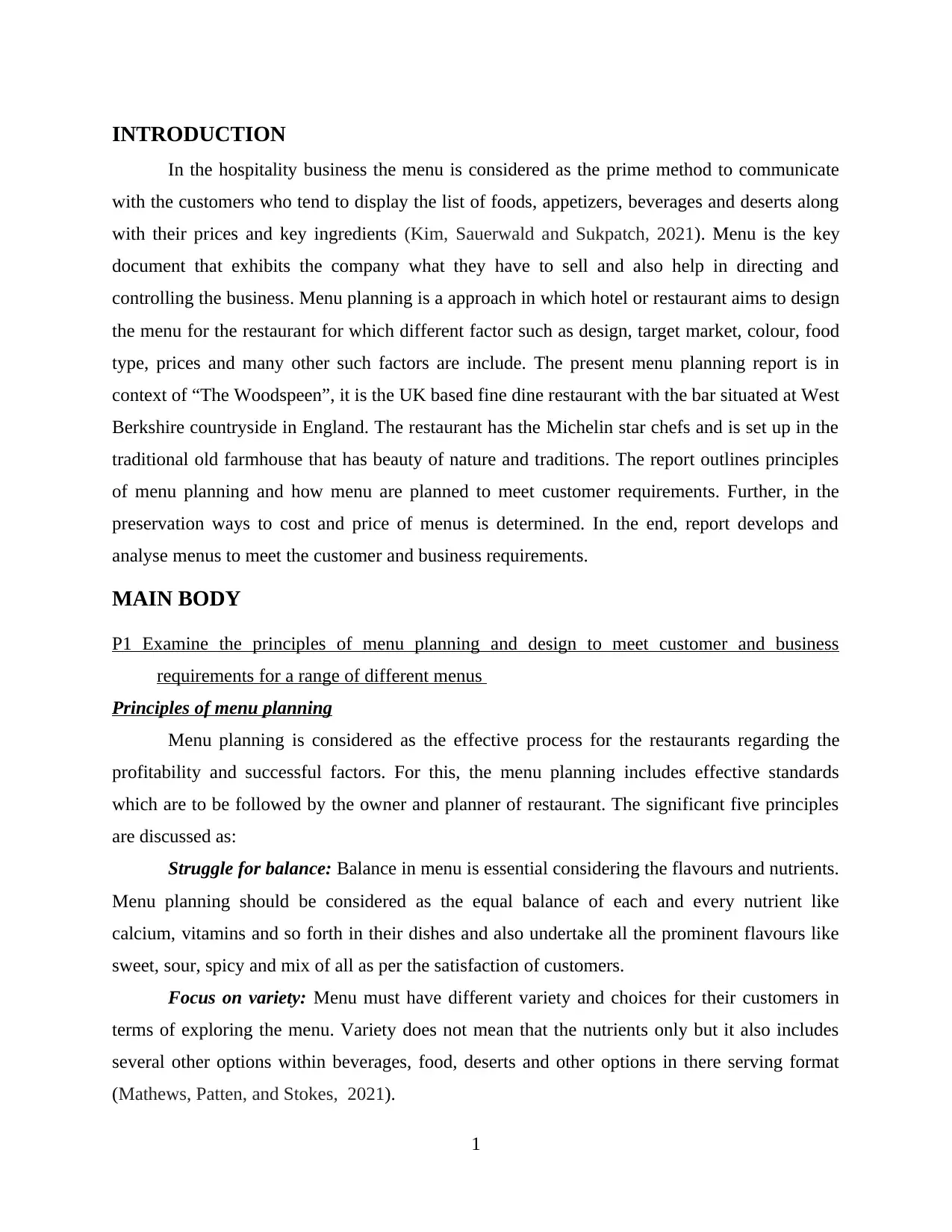
INTRODUCTION
In the hospitality business the menu is considered as the prime method to communicate
with the customers who tend to display the list of foods, appetizers, beverages and deserts along
with their prices and key ingredients (Kim, Sauerwald and Sukpatch, 2021). Menu is the key
document that exhibits the company what they have to sell and also help in directing and
controlling the business. Menu planning is a approach in which hotel or restaurant aims to design
the menu for the restaurant for which different factor such as design, target market, colour, food
type, prices and many other such factors are include. The present menu planning report is in
context of “The Woodspeen”, it is the UK based fine dine restaurant with the bar situated at West
Berkshire countryside in England. The restaurant has the Michelin star chefs and is set up in the
traditional old farmhouse that has beauty of nature and traditions. The report outlines principles
of menu planning and how menu are planned to meet customer requirements. Further, in the
preservation ways to cost and price of menus is determined. In the end, report develops and
analyse menus to meet the customer and business requirements.
MAIN BODY
P1 Examine the principles of menu planning and design to meet customer and business
requirements for a range of different menus
Principles of menu planning
Menu planning is considered as the effective process for the restaurants regarding the
profitability and successful factors. For this, the menu planning includes effective standards
which are to be followed by the owner and planner of restaurant. The significant five principles
are discussed as:
Struggle for balance: Balance in menu is essential considering the flavours and nutrients.
Menu planning should be considered as the equal balance of each and every nutrient like
calcium, vitamins and so forth in their dishes and also undertake all the prominent flavours like
sweet, sour, spicy and mix of all as per the satisfaction of customers.
Focus on variety: Menu must have different variety and choices for their customers in
terms of exploring the menu. Variety does not mean that the nutrients only but it also includes
several other options within beverages, food, deserts and other options in there serving format
(Mathews, Patten, and Stokes, 2021).
1
In the hospitality business the menu is considered as the prime method to communicate
with the customers who tend to display the list of foods, appetizers, beverages and deserts along
with their prices and key ingredients (Kim, Sauerwald and Sukpatch, 2021). Menu is the key
document that exhibits the company what they have to sell and also help in directing and
controlling the business. Menu planning is a approach in which hotel or restaurant aims to design
the menu for the restaurant for which different factor such as design, target market, colour, food
type, prices and many other such factors are include. The present menu planning report is in
context of “The Woodspeen”, it is the UK based fine dine restaurant with the bar situated at West
Berkshire countryside in England. The restaurant has the Michelin star chefs and is set up in the
traditional old farmhouse that has beauty of nature and traditions. The report outlines principles
of menu planning and how menu are planned to meet customer requirements. Further, in the
preservation ways to cost and price of menus is determined. In the end, report develops and
analyse menus to meet the customer and business requirements.
MAIN BODY
P1 Examine the principles of menu planning and design to meet customer and business
requirements for a range of different menus
Principles of menu planning
Menu planning is considered as the effective process for the restaurants regarding the
profitability and successful factors. For this, the menu planning includes effective standards
which are to be followed by the owner and planner of restaurant. The significant five principles
are discussed as:
Struggle for balance: Balance in menu is essential considering the flavours and nutrients.
Menu planning should be considered as the equal balance of each and every nutrient like
calcium, vitamins and so forth in their dishes and also undertake all the prominent flavours like
sweet, sour, spicy and mix of all as per the satisfaction of customers.
Focus on variety: Menu must have different variety and choices for their customers in
terms of exploring the menu. Variety does not mean that the nutrients only but it also includes
several other options within beverages, food, deserts and other options in there serving format
(Mathews, Patten, and Stokes, 2021).
1
Paraphrase This Document
Need a fresh take? Get an instant paraphrase of this document with our AI Paraphraser
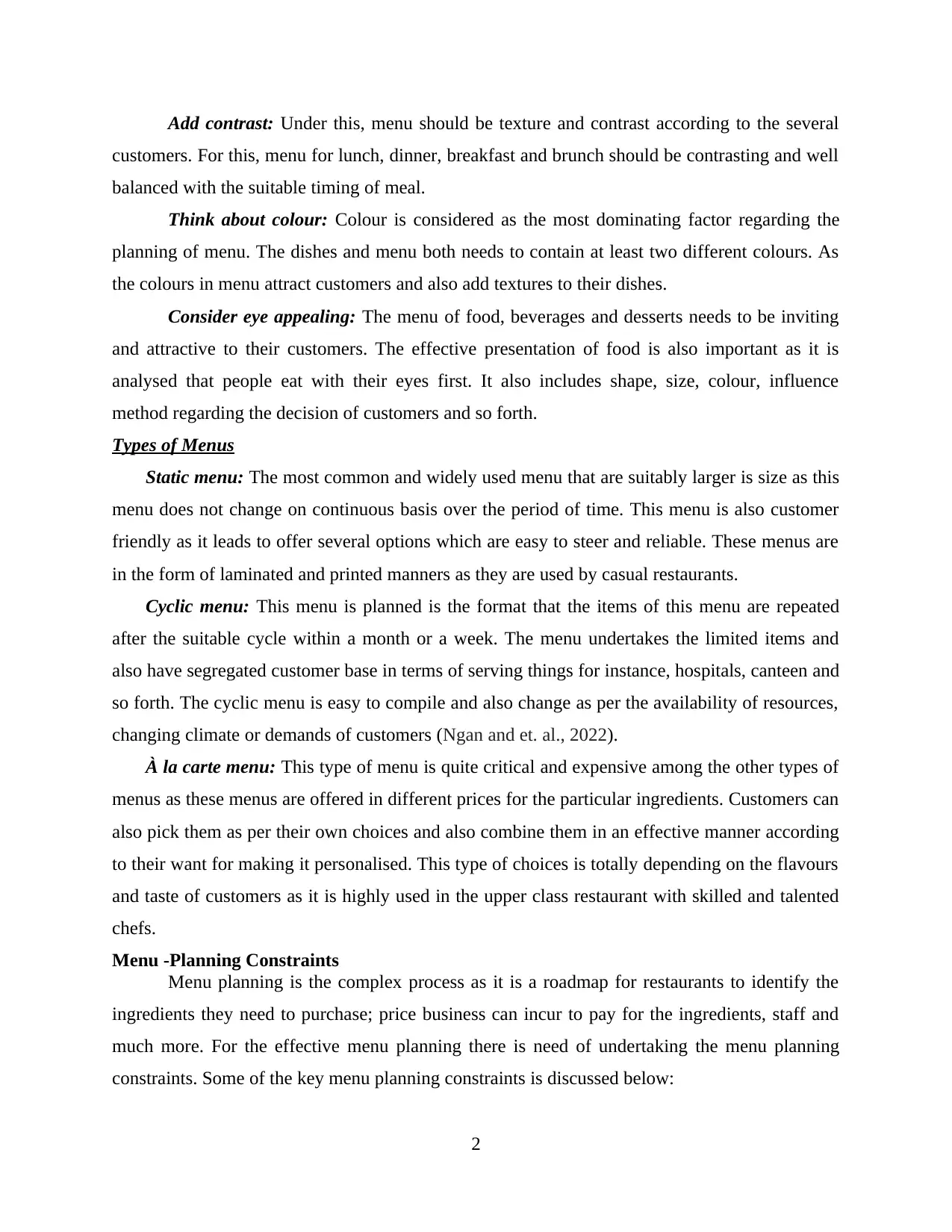
Add contrast: Under this, menu should be texture and contrast according to the several
customers. For this, menu for lunch, dinner, breakfast and brunch should be contrasting and well
balanced with the suitable timing of meal.
Think about colour: Colour is considered as the most dominating factor regarding the
planning of menu. The dishes and menu both needs to contain at least two different colours. As
the colours in menu attract customers and also add textures to their dishes.
Consider eye appealing: The menu of food, beverages and desserts needs to be inviting
and attractive to their customers. The effective presentation of food is also important as it is
analysed that people eat with their eyes first. It also includes shape, size, colour, influence
method regarding the decision of customers and so forth.
Types of Menus
Static menu: The most common and widely used menu that are suitably larger is size as this
menu does not change on continuous basis over the period of time. This menu is also customer
friendly as it leads to offer several options which are easy to steer and reliable. These menus are
in the form of laminated and printed manners as they are used by casual restaurants.
Cyclic menu: This menu is planned is the format that the items of this menu are repeated
after the suitable cycle within a month or a week. The menu undertakes the limited items and
also have segregated customer base in terms of serving things for instance, hospitals, canteen and
so forth. The cyclic menu is easy to compile and also change as per the availability of resources,
changing climate or demands of customers (Ngan and et. al., 2022).
À la carte menu: This type of menu is quite critical and expensive among the other types of
menus as these menus are offered in different prices for the particular ingredients. Customers can
also pick them as per their own choices and also combine them in an effective manner according
to their want for making it personalised. This type of choices is totally depending on the flavours
and taste of customers as it is highly used in the upper class restaurant with skilled and talented
chefs.
Menu -Planning Constraints
Menu planning is the complex process as it is a roadmap for restaurants to identify the
ingredients they need to purchase; price business can incur to pay for the ingredients, staff and
much more. For the effective menu planning there is need of undertaking the menu planning
constraints. Some of the key menu planning constraints is discussed below:
2
customers. For this, menu for lunch, dinner, breakfast and brunch should be contrasting and well
balanced with the suitable timing of meal.
Think about colour: Colour is considered as the most dominating factor regarding the
planning of menu. The dishes and menu both needs to contain at least two different colours. As
the colours in menu attract customers and also add textures to their dishes.
Consider eye appealing: The menu of food, beverages and desserts needs to be inviting
and attractive to their customers. The effective presentation of food is also important as it is
analysed that people eat with their eyes first. It also includes shape, size, colour, influence
method regarding the decision of customers and so forth.
Types of Menus
Static menu: The most common and widely used menu that are suitably larger is size as this
menu does not change on continuous basis over the period of time. This menu is also customer
friendly as it leads to offer several options which are easy to steer and reliable. These menus are
in the form of laminated and printed manners as they are used by casual restaurants.
Cyclic menu: This menu is planned is the format that the items of this menu are repeated
after the suitable cycle within a month or a week. The menu undertakes the limited items and
also have segregated customer base in terms of serving things for instance, hospitals, canteen and
so forth. The cyclic menu is easy to compile and also change as per the availability of resources,
changing climate or demands of customers (Ngan and et. al., 2022).
À la carte menu: This type of menu is quite critical and expensive among the other types of
menus as these menus are offered in different prices for the particular ingredients. Customers can
also pick them as per their own choices and also combine them in an effective manner according
to their want for making it personalised. This type of choices is totally depending on the flavours
and taste of customers as it is highly used in the upper class restaurant with skilled and talented
chefs.
Menu -Planning Constraints
Menu planning is the complex process as it is a roadmap for restaurants to identify the
ingredients they need to purchase; price business can incur to pay for the ingredients, staff and
much more. For the effective menu planning there is need of undertaking the menu planning
constraints. Some of the key menu planning constraints is discussed below:
2
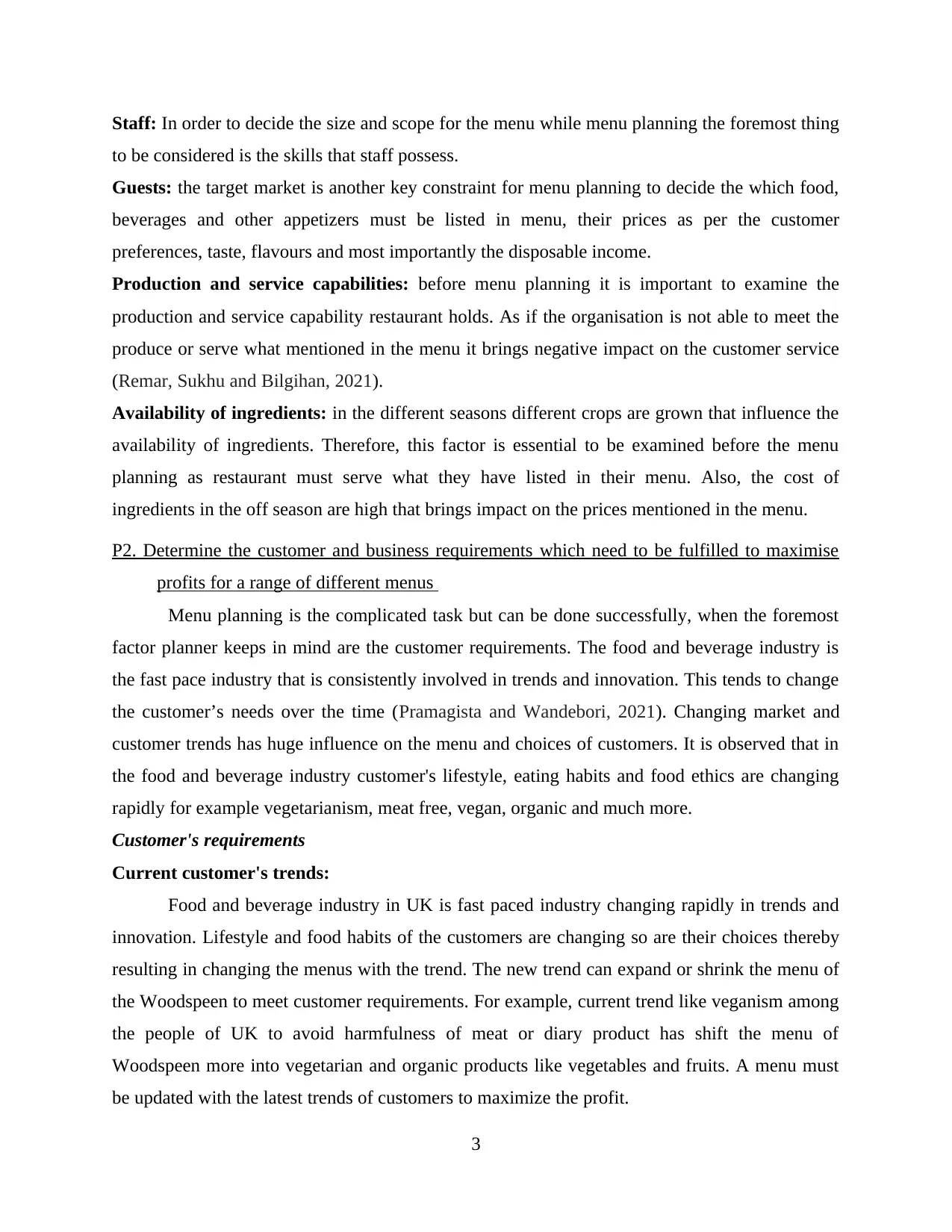
Staff: In order to decide the size and scope for the menu while menu planning the foremost thing
to be considered is the skills that staff possess.
Guests: the target market is another key constraint for menu planning to decide the which food,
beverages and other appetizers must be listed in menu, their prices as per the customer
preferences, taste, flavours and most importantly the disposable income.
Production and service capabilities: before menu planning it is important to examine the
production and service capability restaurant holds. As if the organisation is not able to meet the
produce or serve what mentioned in the menu it brings negative impact on the customer service
(Remar, Sukhu and Bilgihan, 2021).
Availability of ingredients: in the different seasons different crops are grown that influence the
availability of ingredients. Therefore, this factor is essential to be examined before the menu
planning as restaurant must serve what they have listed in their menu. Also, the cost of
ingredients in the off season are high that brings impact on the prices mentioned in the menu.
P2. Determine the customer and business requirements which need to be fulfilled to maximise
profits for a range of different menus
Menu planning is the complicated task but can be done successfully, when the foremost
factor planner keeps in mind are the customer requirements. The food and beverage industry is
the fast pace industry that is consistently involved in trends and innovation. This tends to change
the customer’s needs over the time (Pramagista and Wandebori, 2021). Changing market and
customer trends has huge influence on the menu and choices of customers. It is observed that in
the food and beverage industry customer's lifestyle, eating habits and food ethics are changing
rapidly for example vegetarianism, meat free, vegan, organic and much more.
Customer's requirements
Current customer's trends:
Food and beverage industry in UK is fast paced industry changing rapidly in trends and
innovation. Lifestyle and food habits of the customers are changing so are their choices thereby
resulting in changing the menus with the trend. The new trend can expand or shrink the menu of
the Woodspeen to meet customer requirements. For example, current trend like veganism among
the people of UK to avoid harmfulness of meat or diary product has shift the menu of
Woodspeen more into vegetarian and organic products like vegetables and fruits. A menu must
be updated with the latest trends of customers to maximize the profit.
3
to be considered is the skills that staff possess.
Guests: the target market is another key constraint for menu planning to decide the which food,
beverages and other appetizers must be listed in menu, their prices as per the customer
preferences, taste, flavours and most importantly the disposable income.
Production and service capabilities: before menu planning it is important to examine the
production and service capability restaurant holds. As if the organisation is not able to meet the
produce or serve what mentioned in the menu it brings negative impact on the customer service
(Remar, Sukhu and Bilgihan, 2021).
Availability of ingredients: in the different seasons different crops are grown that influence the
availability of ingredients. Therefore, this factor is essential to be examined before the menu
planning as restaurant must serve what they have listed in their menu. Also, the cost of
ingredients in the off season are high that brings impact on the prices mentioned in the menu.
P2. Determine the customer and business requirements which need to be fulfilled to maximise
profits for a range of different menus
Menu planning is the complicated task but can be done successfully, when the foremost
factor planner keeps in mind are the customer requirements. The food and beverage industry is
the fast pace industry that is consistently involved in trends and innovation. This tends to change
the customer’s needs over the time (Pramagista and Wandebori, 2021). Changing market and
customer trends has huge influence on the menu and choices of customers. It is observed that in
the food and beverage industry customer's lifestyle, eating habits and food ethics are changing
rapidly for example vegetarianism, meat free, vegan, organic and much more.
Customer's requirements
Current customer's trends:
Food and beverage industry in UK is fast paced industry changing rapidly in trends and
innovation. Lifestyle and food habits of the customers are changing so are their choices thereby
resulting in changing the menus with the trend. The new trend can expand or shrink the menu of
the Woodspeen to meet customer requirements. For example, current trend like veganism among
the people of UK to avoid harmfulness of meat or diary product has shift the menu of
Woodspeen more into vegetarian and organic products like vegetables and fruits. A menu must
be updated with the latest trends of customers to maximize the profit.
3
⊘ This is a preview!⊘
Do you want full access?
Subscribe today to unlock all pages.

Trusted by 1+ million students worldwide
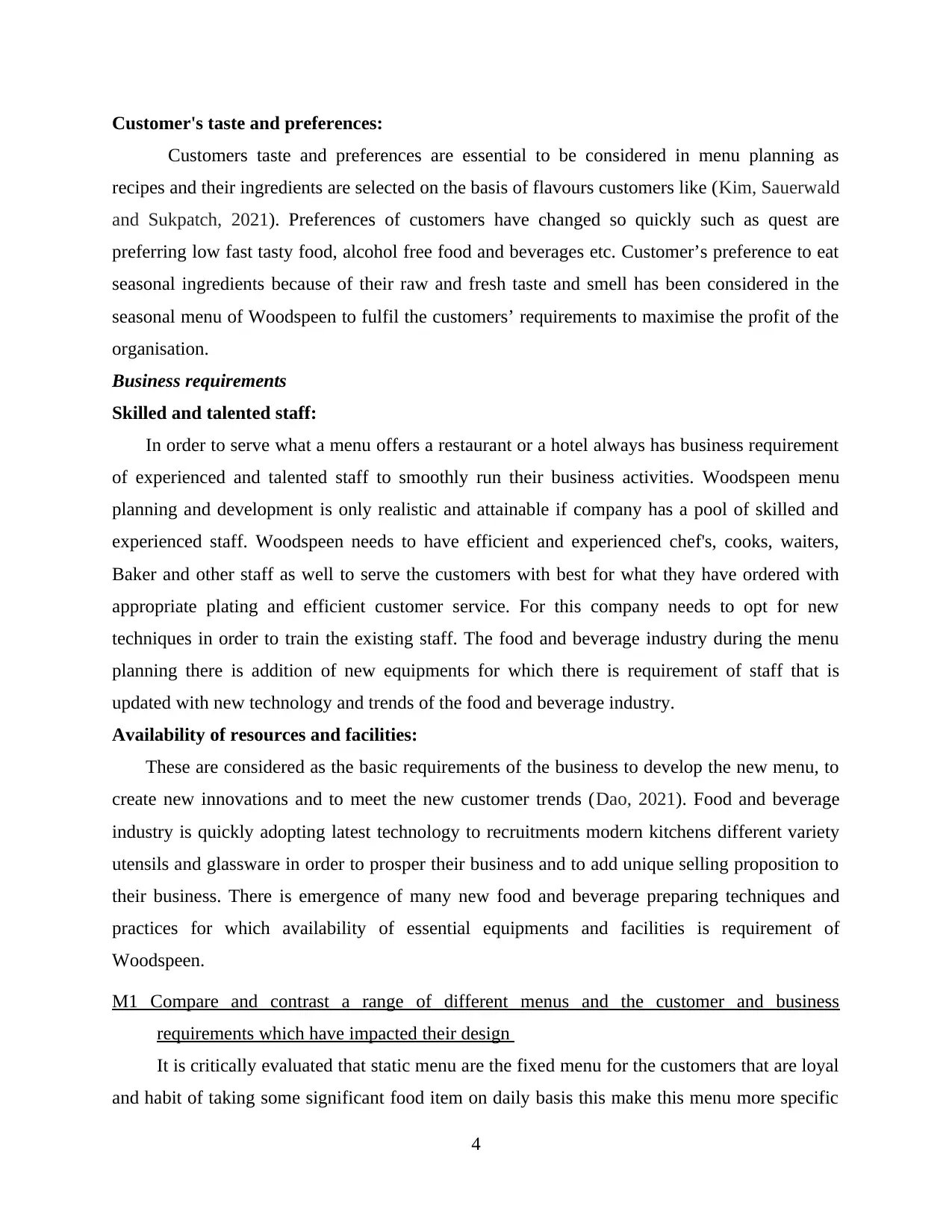
Customer's taste and preferences:
Customers taste and preferences are essential to be considered in menu planning as
recipes and their ingredients are selected on the basis of flavours customers like (Kim, Sauerwald
and Sukpatch, 2021). Preferences of customers have changed so quickly such as quest are
preferring low fast tasty food, alcohol free food and beverages etc. Customer’s preference to eat
seasonal ingredients because of their raw and fresh taste and smell has been considered in the
seasonal menu of Woodspeen to fulfil the customers’ requirements to maximise the profit of the
organisation.
Business requirements
Skilled and talented staff:
In order to serve what a menu offers a restaurant or a hotel always has business requirement
of experienced and talented staff to smoothly run their business activities. Woodspeen menu
planning and development is only realistic and attainable if company has a pool of skilled and
experienced staff. Woodspeen needs to have efficient and experienced chef's, cooks, waiters,
Baker and other staff as well to serve the customers with best for what they have ordered with
appropriate plating and efficient customer service. For this company needs to opt for new
techniques in order to train the existing staff. The food and beverage industry during the menu
planning there is addition of new equipments for which there is requirement of staff that is
updated with new technology and trends of the food and beverage industry.
Availability of resources and facilities:
These are considered as the basic requirements of the business to develop the new menu, to
create new innovations and to meet the new customer trends (Dao, 2021). Food and beverage
industry is quickly adopting latest technology to recruitments modern kitchens different variety
utensils and glassware in order to prosper their business and to add unique selling proposition to
their business. There is emergence of many new food and beverage preparing techniques and
practices for which availability of essential equipments and facilities is requirement of
Woodspeen.
M1 Compare and contrast a range of different menus and the customer and business
requirements which have impacted their design
It is critically evaluated that static menu are the fixed menu for the customers that are loyal
and habit of taking some significant food item on daily basis this make this menu more specific
4
Customers taste and preferences are essential to be considered in menu planning as
recipes and their ingredients are selected on the basis of flavours customers like (Kim, Sauerwald
and Sukpatch, 2021). Preferences of customers have changed so quickly such as quest are
preferring low fast tasty food, alcohol free food and beverages etc. Customer’s preference to eat
seasonal ingredients because of their raw and fresh taste and smell has been considered in the
seasonal menu of Woodspeen to fulfil the customers’ requirements to maximise the profit of the
organisation.
Business requirements
Skilled and talented staff:
In order to serve what a menu offers a restaurant or a hotel always has business requirement
of experienced and talented staff to smoothly run their business activities. Woodspeen menu
planning and development is only realistic and attainable if company has a pool of skilled and
experienced staff. Woodspeen needs to have efficient and experienced chef's, cooks, waiters,
Baker and other staff as well to serve the customers with best for what they have ordered with
appropriate plating and efficient customer service. For this company needs to opt for new
techniques in order to train the existing staff. The food and beverage industry during the menu
planning there is addition of new equipments for which there is requirement of staff that is
updated with new technology and trends of the food and beverage industry.
Availability of resources and facilities:
These are considered as the basic requirements of the business to develop the new menu, to
create new innovations and to meet the new customer trends (Dao, 2021). Food and beverage
industry is quickly adopting latest technology to recruitments modern kitchens different variety
utensils and glassware in order to prosper their business and to add unique selling proposition to
their business. There is emergence of many new food and beverage preparing techniques and
practices for which availability of essential equipments and facilities is requirement of
Woodspeen.
M1 Compare and contrast a range of different menus and the customer and business
requirements which have impacted their design
It is critically evaluated that static menu are the fixed menu for the customers that are loyal
and habit of taking some significant food item on daily basis this make this menu more specific
4
Paraphrase This Document
Need a fresh take? Get an instant paraphrase of this document with our AI Paraphraser
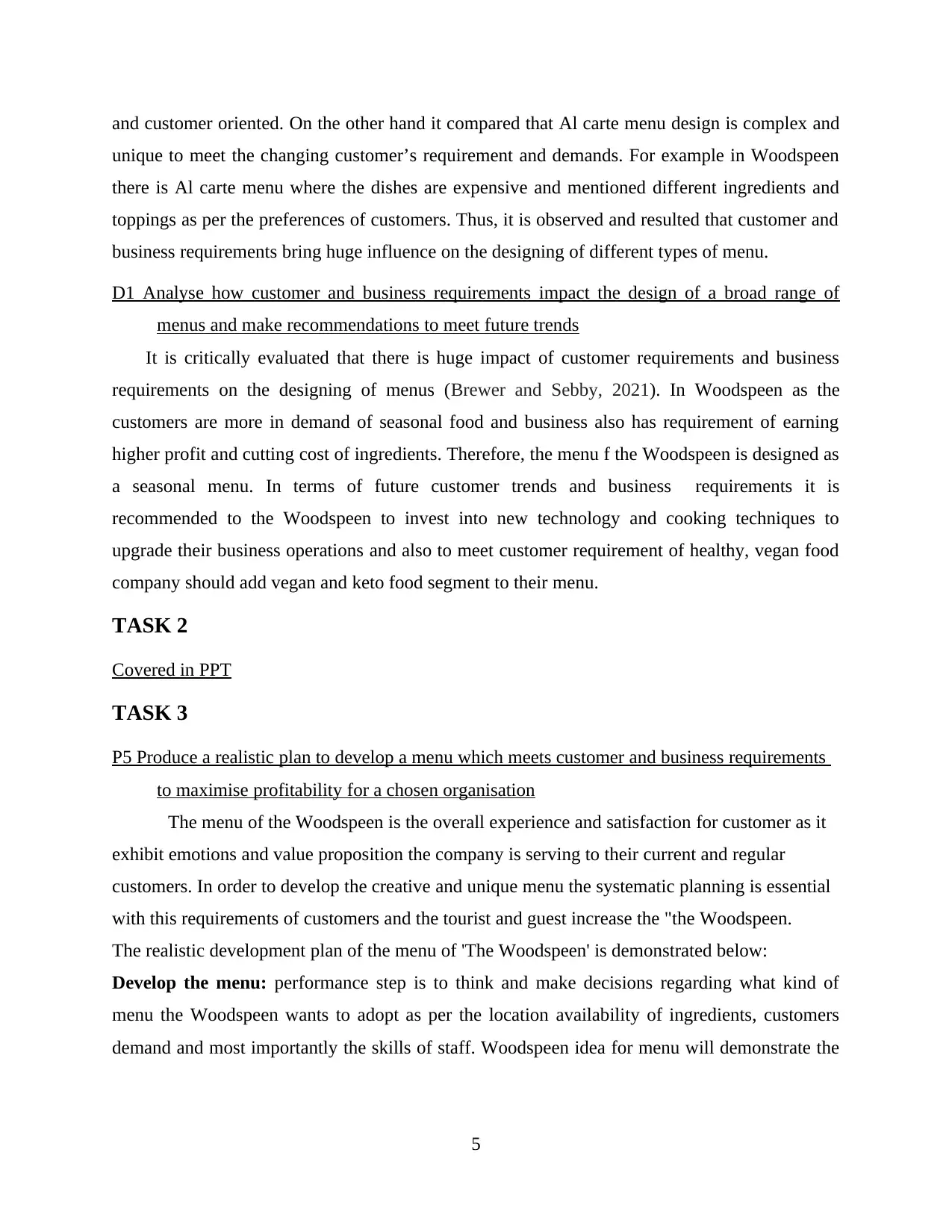
and customer oriented. On the other hand it compared that Al carte menu design is complex and
unique to meet the changing customer’s requirement and demands. For example in Woodspeen
there is Al carte menu where the dishes are expensive and mentioned different ingredients and
toppings as per the preferences of customers. Thus, it is observed and resulted that customer and
business requirements bring huge influence on the designing of different types of menu.
D1 Analyse how customer and business requirements impact the design of a broad range of
menus and make recommendations to meet future trends
It is critically evaluated that there is huge impact of customer requirements and business
requirements on the designing of menus (Brewer and Sebby, 2021). In Woodspeen as the
customers are more in demand of seasonal food and business also has requirement of earning
higher profit and cutting cost of ingredients. Therefore, the menu f the Woodspeen is designed as
a seasonal menu. In terms of future customer trends and business requirements it is
recommended to the Woodspeen to invest into new technology and cooking techniques to
upgrade their business operations and also to meet customer requirement of healthy, vegan food
company should add vegan and keto food segment to their menu.
TASK 2
Covered in PPT
TASK 3
P5 Produce a realistic plan to develop a menu which meets customer and business requirements
to maximise profitability for a chosen organisation
The menu of the Woodspeen is the overall experience and satisfaction for customer as it
exhibit emotions and value proposition the company is serving to their current and regular
customers. In order to develop the creative and unique menu the systematic planning is essential
with this requirements of customers and the tourist and guest increase the "the Woodspeen.
The realistic development plan of the menu of 'The Woodspeen' is demonstrated below:
Develop the menu: performance step is to think and make decisions regarding what kind of
menu the Woodspeen wants to adopt as per the location availability of ingredients, customers
demand and most importantly the skills of staff. Woodspeen idea for menu will demonstrate the
5
unique to meet the changing customer’s requirement and demands. For example in Woodspeen
there is Al carte menu where the dishes are expensive and mentioned different ingredients and
toppings as per the preferences of customers. Thus, it is observed and resulted that customer and
business requirements bring huge influence on the designing of different types of menu.
D1 Analyse how customer and business requirements impact the design of a broad range of
menus and make recommendations to meet future trends
It is critically evaluated that there is huge impact of customer requirements and business
requirements on the designing of menus (Brewer and Sebby, 2021). In Woodspeen as the
customers are more in demand of seasonal food and business also has requirement of earning
higher profit and cutting cost of ingredients. Therefore, the menu f the Woodspeen is designed as
a seasonal menu. In terms of future customer trends and business requirements it is
recommended to the Woodspeen to invest into new technology and cooking techniques to
upgrade their business operations and also to meet customer requirement of healthy, vegan food
company should add vegan and keto food segment to their menu.
TASK 2
Covered in PPT
TASK 3
P5 Produce a realistic plan to develop a menu which meets customer and business requirements
to maximise profitability for a chosen organisation
The menu of the Woodspeen is the overall experience and satisfaction for customer as it
exhibit emotions and value proposition the company is serving to their current and regular
customers. In order to develop the creative and unique menu the systematic planning is essential
with this requirements of customers and the tourist and guest increase the "the Woodspeen.
The realistic development plan of the menu of 'The Woodspeen' is demonstrated below:
Develop the menu: performance step is to think and make decisions regarding what kind of
menu the Woodspeen wants to adopt as per the location availability of ingredients, customers
demand and most importantly the skills of staff. Woodspeen idea for menu will demonstrate the
5
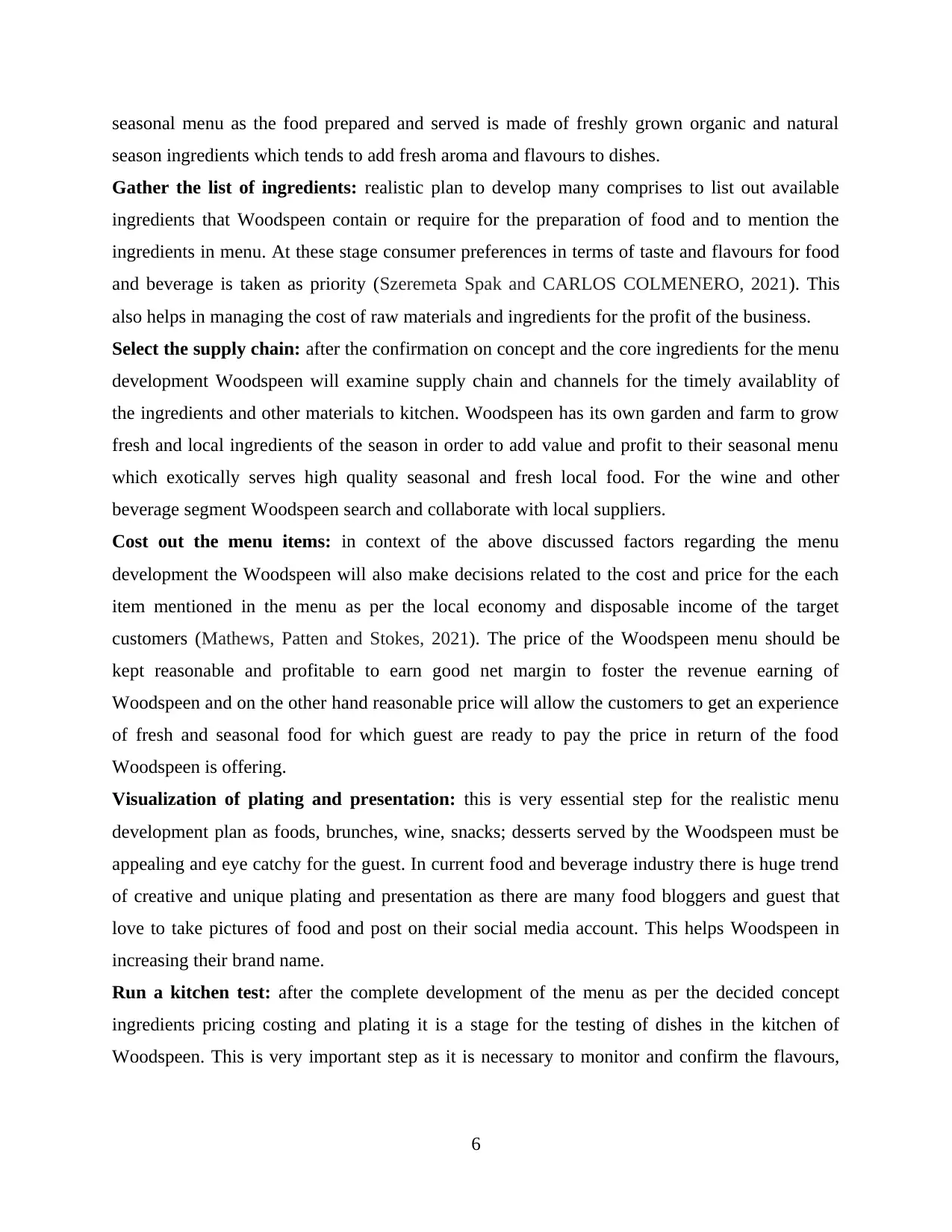
seasonal menu as the food prepared and served is made of freshly grown organic and natural
season ingredients which tends to add fresh aroma and flavours to dishes.
Gather the list of ingredients: realistic plan to develop many comprises to list out available
ingredients that Woodspeen contain or require for the preparation of food and to mention the
ingredients in menu. At these stage consumer preferences in terms of taste and flavours for food
and beverage is taken as priority (Szeremeta Spak and CARLOS COLMENERO, 2021). This
also helps in managing the cost of raw materials and ingredients for the profit of the business.
Select the supply chain: after the confirmation on concept and the core ingredients for the menu
development Woodspeen will examine supply chain and channels for the timely availablity of
the ingredients and other materials to kitchen. Woodspeen has its own garden and farm to grow
fresh and local ingredients of the season in order to add value and profit to their seasonal menu
which exotically serves high quality seasonal and fresh local food. For the wine and other
beverage segment Woodspeen search and collaborate with local suppliers.
Cost out the menu items: in context of the above discussed factors regarding the menu
development the Woodspeen will also make decisions related to the cost and price for the each
item mentioned in the menu as per the local economy and disposable income of the target
customers (Mathews, Patten and Stokes, 2021). The price of the Woodspeen menu should be
kept reasonable and profitable to earn good net margin to foster the revenue earning of
Woodspeen and on the other hand reasonable price will allow the customers to get an experience
of fresh and seasonal food for which guest are ready to pay the price in return of the food
Woodspeen is offering.
Visualization of plating and presentation: this is very essential step for the realistic menu
development plan as foods, brunches, wine, snacks; desserts served by the Woodspeen must be
appealing and eye catchy for the guest. In current food and beverage industry there is huge trend
of creative and unique plating and presentation as there are many food bloggers and guest that
love to take pictures of food and post on their social media account. This helps Woodspeen in
increasing their brand name.
Run a kitchen test: after the complete development of the menu as per the decided concept
ingredients pricing costing and plating it is a stage for the testing of dishes in the kitchen of
Woodspeen. This is very important step as it is necessary to monitor and confirm the flavours,
6
season ingredients which tends to add fresh aroma and flavours to dishes.
Gather the list of ingredients: realistic plan to develop many comprises to list out available
ingredients that Woodspeen contain or require for the preparation of food and to mention the
ingredients in menu. At these stage consumer preferences in terms of taste and flavours for food
and beverage is taken as priority (Szeremeta Spak and CARLOS COLMENERO, 2021). This
also helps in managing the cost of raw materials and ingredients for the profit of the business.
Select the supply chain: after the confirmation on concept and the core ingredients for the menu
development Woodspeen will examine supply chain and channels for the timely availablity of
the ingredients and other materials to kitchen. Woodspeen has its own garden and farm to grow
fresh and local ingredients of the season in order to add value and profit to their seasonal menu
which exotically serves high quality seasonal and fresh local food. For the wine and other
beverage segment Woodspeen search and collaborate with local suppliers.
Cost out the menu items: in context of the above discussed factors regarding the menu
development the Woodspeen will also make decisions related to the cost and price for the each
item mentioned in the menu as per the local economy and disposable income of the target
customers (Mathews, Patten and Stokes, 2021). The price of the Woodspeen menu should be
kept reasonable and profitable to earn good net margin to foster the revenue earning of
Woodspeen and on the other hand reasonable price will allow the customers to get an experience
of fresh and seasonal food for which guest are ready to pay the price in return of the food
Woodspeen is offering.
Visualization of plating and presentation: this is very essential step for the realistic menu
development plan as foods, brunches, wine, snacks; desserts served by the Woodspeen must be
appealing and eye catchy for the guest. In current food and beverage industry there is huge trend
of creative and unique plating and presentation as there are many food bloggers and guest that
love to take pictures of food and post on their social media account. This helps Woodspeen in
increasing their brand name.
Run a kitchen test: after the complete development of the menu as per the decided concept
ingredients pricing costing and plating it is a stage for the testing of dishes in the kitchen of
Woodspeen. This is very important step as it is necessary to monitor and confirm the flavours,
6
⊘ This is a preview!⊘
Do you want full access?
Subscribe today to unlock all pages.

Trusted by 1+ million students worldwide
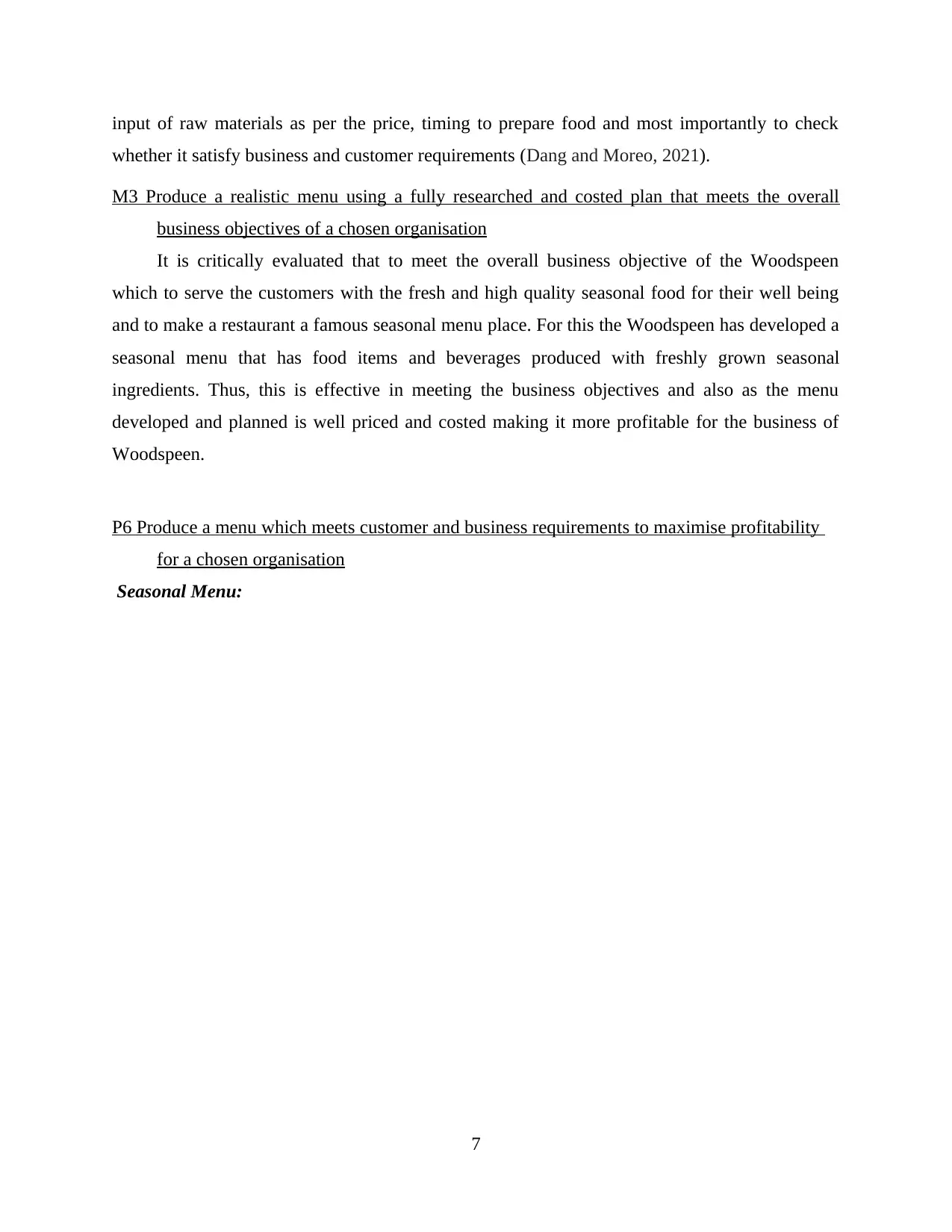
input of raw materials as per the price, timing to prepare food and most importantly to check
whether it satisfy business and customer requirements (Dang and Moreo, 2021).
M3 Produce a realistic menu using a fully researched and costed plan that meets the overall
business objectives of a chosen organisation
It is critically evaluated that to meet the overall business objective of the Woodspeen
which to serve the customers with the fresh and high quality seasonal food for their well being
and to make a restaurant a famous seasonal menu place. For this the Woodspeen has developed a
seasonal menu that has food items and beverages produced with freshly grown seasonal
ingredients. Thus, this is effective in meeting the business objectives and also as the menu
developed and planned is well priced and costed making it more profitable for the business of
Woodspeen.
P6 Produce a menu which meets customer and business requirements to maximise profitability
for a chosen organisation
Seasonal Menu:
7
whether it satisfy business and customer requirements (Dang and Moreo, 2021).
M3 Produce a realistic menu using a fully researched and costed plan that meets the overall
business objectives of a chosen organisation
It is critically evaluated that to meet the overall business objective of the Woodspeen
which to serve the customers with the fresh and high quality seasonal food for their well being
and to make a restaurant a famous seasonal menu place. For this the Woodspeen has developed a
seasonal menu that has food items and beverages produced with freshly grown seasonal
ingredients. Thus, this is effective in meeting the business objectives and also as the menu
developed and planned is well priced and costed making it more profitable for the business of
Woodspeen.
P6 Produce a menu which meets customer and business requirements to maximise profitability
for a chosen organisation
Seasonal Menu:
7
Paraphrase This Document
Need a fresh take? Get an instant paraphrase of this document with our AI Paraphraser
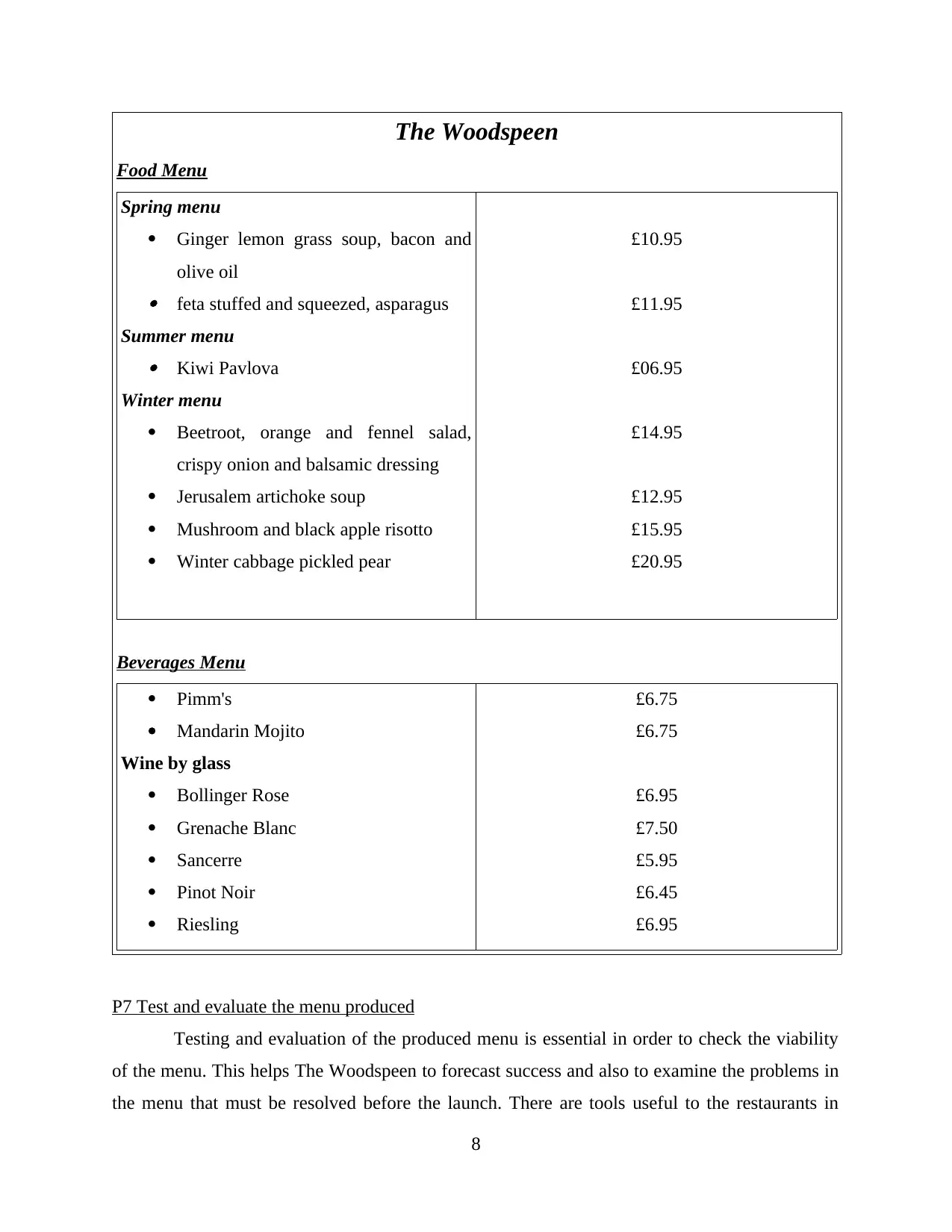
The Woodspeen
Food Menu
Spring menu
Ginger lemon grass soup, bacon and
olive oil feta stuffed and squeezed, asparagus
Summer menu Kiwi Pavlova
Winter menu
Beetroot, orange and fennel salad,
crispy onion and balsamic dressing
Jerusalem artichoke soup
Mushroom and black apple risotto
Winter cabbage pickled pear
£10.95
£11.95
£06.95
£14.95
£12.95
£15.95
£20.95
Beverages Menu
Pimm's
Mandarin Mojito
Wine by glass
Bollinger Rose
Grenache Blanc
Sancerre
Pinot Noir
Riesling
£6.75
£6.75
£6.95
£7.50
£5.95
£6.45
£6.95
P7 Test and evaluate the menu produced
Testing and evaluation of the produced menu is essential in order to check the viability
of the menu. This helps The Woodspeen to forecast success and also to examine the problems in
the menu that must be resolved before the launch. There are tools useful to the restaurants in
8
Food Menu
Spring menu
Ginger lemon grass soup, bacon and
olive oil feta stuffed and squeezed, asparagus
Summer menu Kiwi Pavlova
Winter menu
Beetroot, orange and fennel salad,
crispy onion and balsamic dressing
Jerusalem artichoke soup
Mushroom and black apple risotto
Winter cabbage pickled pear
£10.95
£11.95
£06.95
£14.95
£12.95
£15.95
£20.95
Beverages Menu
Pimm's
Mandarin Mojito
Wine by glass
Bollinger Rose
Grenache Blanc
Sancerre
Pinot Noir
Riesling
£6.75
£6.75
£6.95
£7.50
£5.95
£6.45
£6.95
P7 Test and evaluate the menu produced
Testing and evaluation of the produced menu is essential in order to check the viability
of the menu. This helps The Woodspeen to forecast success and also to examine the problems in
the menu that must be resolved before the launch. There are tools useful to the restaurants in
8
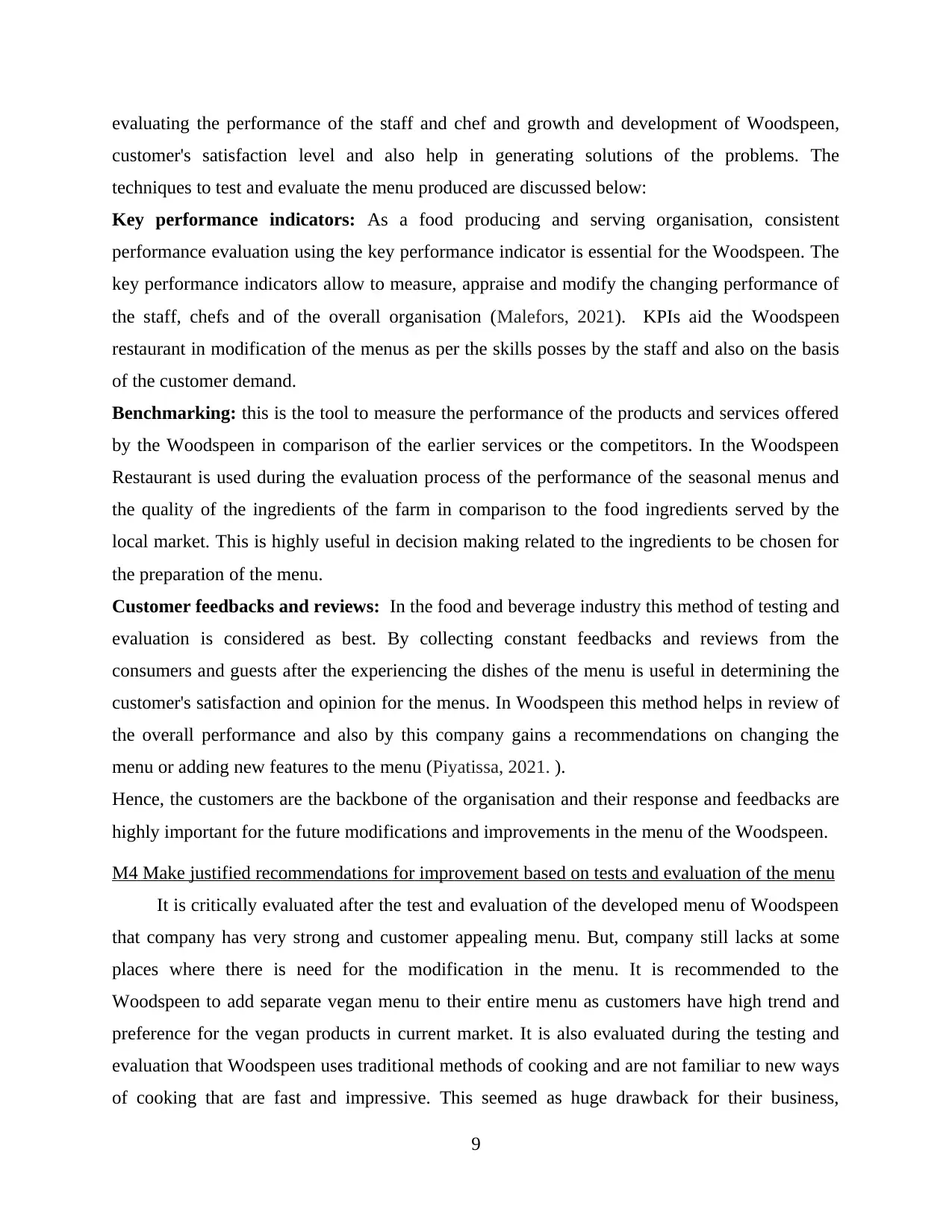
evaluating the performance of the staff and chef and growth and development of Woodspeen,
customer's satisfaction level and also help in generating solutions of the problems. The
techniques to test and evaluate the menu produced are discussed below:
Key performance indicators: As a food producing and serving organisation, consistent
performance evaluation using the key performance indicator is essential for the Woodspeen. The
key performance indicators allow to measure, appraise and modify the changing performance of
the staff, chefs and of the overall organisation (Malefors, 2021). KPIs aid the Woodspeen
restaurant in modification of the menus as per the skills posses by the staff and also on the basis
of the customer demand.
Benchmarking: this is the tool to measure the performance of the products and services offered
by the Woodspeen in comparison of the earlier services or the competitors. In the Woodspeen
Restaurant is used during the evaluation process of the performance of the seasonal menus and
the quality of the ingredients of the farm in comparison to the food ingredients served by the
local market. This is highly useful in decision making related to the ingredients to be chosen for
the preparation of the menu.
Customer feedbacks and reviews: In the food and beverage industry this method of testing and
evaluation is considered as best. By collecting constant feedbacks and reviews from the
consumers and guests after the experiencing the dishes of the menu is useful in determining the
customer's satisfaction and opinion for the menus. In Woodspeen this method helps in review of
the overall performance and also by this company gains a recommendations on changing the
menu or adding new features to the menu (Piyatissa, 2021. ).
Hence, the customers are the backbone of the organisation and their response and feedbacks are
highly important for the future modifications and improvements in the menu of the Woodspeen.
M4 Make justified recommendations for improvement based on tests and evaluation of the menu
It is critically evaluated after the test and evaluation of the developed menu of Woodspeen
that company has very strong and customer appealing menu. But, company still lacks at some
places where there is need for the modification in the menu. It is recommended to the
Woodspeen to add separate vegan menu to their entire menu as customers have high trend and
preference for the vegan products in current market. It is also evaluated during the testing and
evaluation that Woodspeen uses traditional methods of cooking and are not familiar to new ways
of cooking that are fast and impressive. This seemed as huge drawback for their business,
9
customer's satisfaction level and also help in generating solutions of the problems. The
techniques to test and evaluate the menu produced are discussed below:
Key performance indicators: As a food producing and serving organisation, consistent
performance evaluation using the key performance indicator is essential for the Woodspeen. The
key performance indicators allow to measure, appraise and modify the changing performance of
the staff, chefs and of the overall organisation (Malefors, 2021). KPIs aid the Woodspeen
restaurant in modification of the menus as per the skills posses by the staff and also on the basis
of the customer demand.
Benchmarking: this is the tool to measure the performance of the products and services offered
by the Woodspeen in comparison of the earlier services or the competitors. In the Woodspeen
Restaurant is used during the evaluation process of the performance of the seasonal menus and
the quality of the ingredients of the farm in comparison to the food ingredients served by the
local market. This is highly useful in decision making related to the ingredients to be chosen for
the preparation of the menu.
Customer feedbacks and reviews: In the food and beverage industry this method of testing and
evaluation is considered as best. By collecting constant feedbacks and reviews from the
consumers and guests after the experiencing the dishes of the menu is useful in determining the
customer's satisfaction and opinion for the menus. In Woodspeen this method helps in review of
the overall performance and also by this company gains a recommendations on changing the
menu or adding new features to the menu (Piyatissa, 2021. ).
Hence, the customers are the backbone of the organisation and their response and feedbacks are
highly important for the future modifications and improvements in the menu of the Woodspeen.
M4 Make justified recommendations for improvement based on tests and evaluation of the menu
It is critically evaluated after the test and evaluation of the developed menu of Woodspeen
that company has very strong and customer appealing menu. But, company still lacks at some
places where there is need for the modification in the menu. It is recommended to the
Woodspeen to add separate vegan menu to their entire menu as customers have high trend and
preference for the vegan products in current market. It is also evaluated during the testing and
evaluation that Woodspeen uses traditional methods of cooking and are not familiar to new ways
of cooking that are fast and impressive. This seemed as huge drawback for their business,
9
⊘ This is a preview!⊘
Do you want full access?
Subscribe today to unlock all pages.

Trusted by 1+ million students worldwide
1 out of 14
Related Documents
Your All-in-One AI-Powered Toolkit for Academic Success.
+13062052269
info@desklib.com
Available 24*7 on WhatsApp / Email
![[object Object]](/_next/static/media/star-bottom.7253800d.svg)
Unlock your academic potential
Copyright © 2020–2025 A2Z Services. All Rights Reserved. Developed and managed by ZUCOL.
